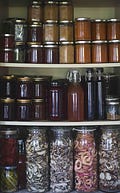The Seasonal Supplement: Issue 2, Late-Autumn
storecupboard silliness | ever-changing pesto | elephant garlic
November on the smallholding. The last leaves and apples tumble from the trees, smoke wafts through the air from nearby chimneys, and there is a tangible slowing of tempo as we move towards winter. We still have plenty of things to do, but the jobs are shorter, quicker, often rushed, so that they can be squeezed into daylight hours. Cutting hedges. Raki…


